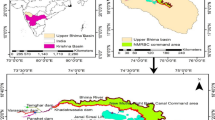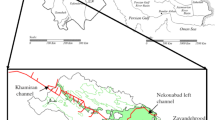Abstract
A two-step infinite α-cuts fuzzy linear programming (TSIFP) method is developed in this study. The introduction of infinite α-cuts to conventional fuzzy linear programming frameworks makes it possible to generate more reliable optimal results than conventional fuzzy linear programming, where finite α-cuts were assumed to be sufficient in representing all fuzzy information of the membership functions. In contrast to the previous studies, the proposed TSIFP can be noted as the first attempt in solving FLP without any unreasonable simplification and assumption. An agricultural irrigation system is then provided for demonstrating its applicability. The results show that reasonable solutions and allocation strategies are obtained. As a typical finite α-cuts fuzzy linear programming method, fuzzy robust linear programming (FRLP) is further considered to solve the same problem; results from this method are then compared with those from TSIFP. It is indicated that, due to the constraints being relaxed in FRLP, more water beyond the system’s capacity would be over-allocated for pursuing higher system benefits, implying the unreliability of FRLP in being extended to real-world practices. Two scenario analyses under different α-level cutting means for FRLP are also investigated.
Similar content being viewed by others
References
Anderson EJ, Nash P (1987) Linear programming in infinite-dimensional spaces: theory and applications. Wiley, London
Ben-Tal A, Nemirovski A (1998) Robust convex optimization. Math Oper Res 23:769–805
Ben-Tal A, Nemirovski A (1999) Robust solutions to uncertain linear programs. Oper Res Lett 25:1–13
Birge JR, Louveaux FV (1988) A multicut algorithm for two-stage stochastic linear programs. Eur J Oper Res 34:384–392
Buckley JJ (1989) A fast method of ranking alternatives using fuzzy numbers. Fuzzy Sets Syst 30:337–338
Chiang JS (2001) Fuzzy linear programming based on statistical confidence interval and interval-valued fuzzy set. Eur J Oper Res 129(1):65–86
Delgado M, Verdegay JL, Vila MA (1989) A general model for fuzzy linear programming. Fuzzy Sets and Syst 29:21–29
Dupacova J (1998) Reflections on robust optimization. Lect Notes Econ Math Syst 458:111–127
El Ghaoui L, Seigneuret F (1998) Robust optimization methodologies for the free route concept. Proc Am Control Conf 1797–1799
Fang SC, Puthenpura SC (1993) Linear optimization and extensions: theory and algorithms. Prentice Hall, Englewood Cliffs
Fang SC, Hu CF, Wang HF et al (1999) Linear programming with fuzzy coefficients in constraints. Comput Math Appl 37:63–76
Gorzalczany MB (1987) A method of inference in approximate reasoning based on interval-valued fuzzy sets. Fuzzy Sets Syst 21:1–17
Guo HC, Zou R, Xu YL, Huang GH et al (1999) An inexact fuzzy multi-objective programming method and its application to the watershed environmental planning—II. case study. Environ Sci 19(1):33–37
He L, Huang GH, Liao RF et al (2004) Stochastic optimization programming for multi-reach river system using GA combined with stochastic simulation. Trans Nonferr Met Soc China 14(Special 1):31–36
He L, Huang GH, Zeng GM et al (2008) Wavelet-based multiresolution analysis technique for data cleaning and its application to water quality management system. Expert Syst Appl 35(3):1301–1310. doi:10.1016/j.eswa.2007.08.009
He L, Huang GH, Zeng GM et al (2009) Identifying optimal regional solid waste management strategies through a new inexact integer programming model containing infinite objectives and constraints. Waste Manage 29(1):21–31. doi:10.1016/j.wasman.2008.02.003
Huang GH, Baetz BW, Patry GG (1998) Trash flow allocation: planning under uncertainty. Interfaces 28(6):36–55
Huang GH, Sae-Lim N, Liu L et al (2001) An interval-parameter fuzzy-stochastic programming approach for municipal solid waste management and planning. Environ Model Assess 6(4):271–283
Huang YF, Baetz BW, Huang GH et al (2002) Violation analysis for solid waste management systems: an interval fuzzy programming approach. J Environ Manag 65(4):431–446
Huang GH, He L, Zeng GM et al (2008) Identification of the optimal urban solid waste flow schemes under impacts of energy prices. Environ Eng Sci 25(5):686–696. doi:10.1089/ees.2007.0078
Inuiguchi M, Sakawa M (1998) Robust optimization under softness in a fuzzy linear programming problem. Int J Approx Reason 18:21–34
Inuiguchi M, Ramik J, Tanino T et al (2003) Satisficing solutions and duality in interval and fuzzy linear programming. Fuzzy Sets Syst 135(1):151–177
Kizer M (1991) Alfalfa irrigation. Chapter 6. In: Alfalfa production and pest management in Oklahoma. Circular E-826. Oklahoma Cooperative Extension Service
Lai YJ, Hwang CL (1992) Fuzzy mathematical programming: methods and applications. Springer, Heidelberg
Lee YW, Bogardi I, Stansbury J (1991) Fuzzy decision making in dredged-material management. J Environ Eng ASCE 117(2):614–628
Li JB, Huang GH, Chakma A et al (2003) Integrated fuzzy-stochastic modeling of petroleum contamination in subsurface. Energy Sources 25(6):547–564
Lin XC, Lee LH (2006) A new approach to discrete stochastic optimization problems. Eur J Oper Res 172(3):761–782
Liu L, Huang GH, Liu Y et al (2003) A fuzzy-stochastic robust programming model for regional air quality management under uncertainty. Eng Optim 35(2):177–199
Loucks DP, Stedinger JR, Haith DA (1981) Water resource systems planning and analysis. Prentice-Hall, Englewood Cliffs
Lu HW, Huang GH, Zeng GM et al (2008a) An inexact two-stage fuzzy-stochastic programming model for water resources management. Water Resour Manag 22(8):991–1016. doi:10.1007/s11269-007-9206-8
Lu HW, Huang GH, He L (2008b) A SIA-based inexact two-stage stochastic fuzzy linear programming approach for water resources management. Eng Optim. doi:10.1080/03052150802345987
Lu HW, Huang GH, He L (2008c) An inexact programming method for agricultural irrigation systems under parameter uncertainty. Stoch Environ Res Risk Assess. doi:10.1007/s00477-008-0256-0
Lu HW, Huang GH, Liu L et al (2008d) An interval-parameter fuzzy-stochastic programming approach for air quality management under uncertainty. Environ Eng Sci 25(6):895–910
Maqsood I (2004) Development of simulation- and optimization-based decision support methodologies for environmental systems management. Ph.D. Thesis, University of Regina, Regina, Saskatchewan, Canada
Maqsood I, Huang GH, Yeomans JS (2005) An interval-parameter fuzzy two-stage stochastic program for water resources management under uncertainty. Eur J Oper Res 167(1):208–225
Rommelfanger H (2004) The advantages of fuzzy optimization models in practical use. Fuzzy Optim Decis Making 3:295–309
Stichler C (1997) Texas alfalfa production. Texas Agricultural Extension Service B-5017. College Station, TX
Tanaka H, Ichihashi H, Asai K (1984) A formulation of fuzzy linear programming problems based on comparison of fuzzy numbers. Control Cybernet 13:185–194
Tong SC (1994) Interval number and fuzzy number linear programmings. Fuzzy Sets Syst 66(3):301–306
Trostle C (2003) Texas high plains supplement to Texas alfalfa production. Texas Cooperative Extension Bulletin B-5017. Lubbock, TX
Vasant PM (2003) Application of fuzzy linear programming in production planning. Fuzzy Optim Decis Making 3:229–241
Wang DW (1997) An inexact approach for linear programming problems with fuzzy objective and resources. Fuzzy Sets Syst 89:61–68
Wang LJ, Meng W, Guo HC et al (2006) An interval fuzzy multiobjective watershed management model for the Lake Qionghai watershed, China. Water Resour Manag 20(5):701–721
Zadeh LA (1965) Fuzzy sets. Inf Control 8:338–353
Zimmermann HJ (1976) Description and optimization of fuzzy system. Int J Gen Syst 2:209–216
Zimmermann HJ (1991) Fuzzy set theory and its applications. Kluwer, Norwell
Zou R, Lung WS, Guo HC et al (2000) Independent variable controlled grey fuzzy linear programming approach for waste flow allocation planning. Eng Optim 33(1):87–111
Author information
Authors and Affiliations
Corresponding author
Rights and permissions
About this article
Cite this article
Lu, H.W., Huang, G.H., Lin, Y.P. et al. A Two-Step Infinite α-Cuts Fuzzy Linear Programming Method in Determination of Optimal Allocation Strategies in Agricultural Irrigation Systems. Water Resour Manage 23, 2249–2269 (2009). https://doi.org/10.1007/s11269-008-9380-3
Received:
Accepted:
Published:
Issue Date:
DOI: https://doi.org/10.1007/s11269-008-9380-3




